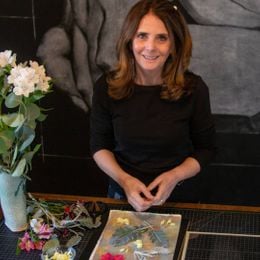Possibilities In the Pursuit of Art
My husband was the artist and I was the writer — until I began creating without words
We knew who we were: My husband was the artist. I wrote. There we were from the very start, in a third-floor room of a West Philadelphia row house — Bill at work with his squares of watercolor, his brush, his postcard-sized Arches paper, and me scribbling poems into a journal.
His workspace was a hollow-core door supported by sawhorses. Mine was the lump of the mattress that consumed half the floor. No bed frame in sight. Linseed oil, not a bowl of apples, in the kitchen. Though sometimes we had chips and Coke.

Years went by. A son was born. Old houses became homes. The artist husband. The writer wife. And then my father died in the height of COVID. A storm blew in, and he was gone, and with him went my words. I ached to use my hands to appease the hurt in my heart. I wanted to stand, not sit. To call his phone and find him there. To apologize for words unsaid, and then to be forgiven.
I wanted something — anything — that would keep me tethered to the present hour.
I ached to use my hands to appease the hurt in my heart.
In Pursuit of Art
I might have gardened but it was a long, hot August, and soon it would be fall. I might have done more in the kitchen, but I had little appetite. And so, I ordered a box of acrylic paints, one gelli plate, and two brayers (small rollers); waxed thread, needles, an awl, and glue; an X-acto knife and extra blades; one fat stack of heavyweight paper and a ream of the lighter stuff. And waited.
The box arrived in mid-October. The already-tight quarters of our kitchen took on double duty as my art-making space. I began to stand for hours at a time. I was in pursuit of art.
Art. The word had never applied to me. I'd drawn a butterfly as a kid. I'd colored cut-out doll clothes. I'd made a macrame plant holder and a thousand beaded rings. And later in life, at a local art center, I'd glazed the stoneware pots my husband had thrown when it became clear that I couldn't master the wheel.
Oh, the quiet squeak of the brayers as they rolled over the soft, relenting gelli plate.
I had no idea, in other words, what I was doing with that box of supplies and my little trolley cart, the surface of which became my workspace. I made rough art things before breakfast. I made them after the dishes were washed. I made them following the dinner hour — the smell of garlic or ginger or split strawberries still in the air around me. Meanwhile my husband went off to the cobwebbed basement where he now had a wheel of his own, or out to the garage, to paint.
He would have answered any questions I might have asked. But I couldn't even imagine the questions.
But oh, those acrylics. Oh, the quiet squeak of the brayers as they rolled over the soft, relenting gelli plate. Oh, the brand-new hues that emerged as cerulean blue was rolled into cobalt teal, or diarylide yellow caught an edge of dioxazine purple.
How Profitable Failure Can Be
I harvested rhododendron leaves still clinging to their branches, bought grocery-store bouquets of Peruvian lilies, and scrounged up old lace and taught myself the old, instinctive art of gelli printing. When the "art" dried, I made cards, then I made simple journals.
I hadn't recognized how peaceful it can be to stand with something you have made and look for its surprises.
At the end of most days, I was sure that I'd reached my maximum capacity as an amateur artist. Then the next day I began again and something new occurred — new knowledge about color, new knowledge about shape, new knowledge about what a blank book might be, a book that asked nothing of a writer.
All through our many married years, my husband and I had spoken of his work — work I intuitively love — in ways limited by my standing as an artist outsider. I hadn't really understood how luscious fine hot-press paper is to the touch. I hadn't recognized how peaceful it can be to stand with something you have made and look for its surprises. I hadn't known how profitable failure can be — how failure forces you to try again, but in another, more interesting way.
How, in failing, you come to see new possibilities within yourself — gains, in the aftermath of loss.
I hadn't understood, but now I did. I saw my husband with new eyes. I saw my own self differently, too.
I still can't draw a perfect circle. I will never reproduce my childhood feat of a blue butterfly with wings so fine I convinced myself they could fly.
But in my life a new calm has entered in — the calm that hands can yield when hearts are broken and minds yearn for a blessed retreat from words.


